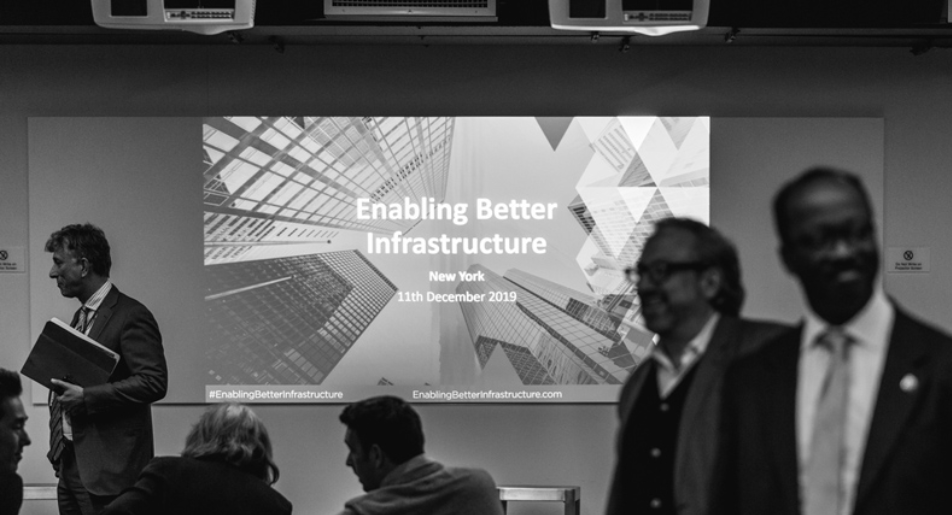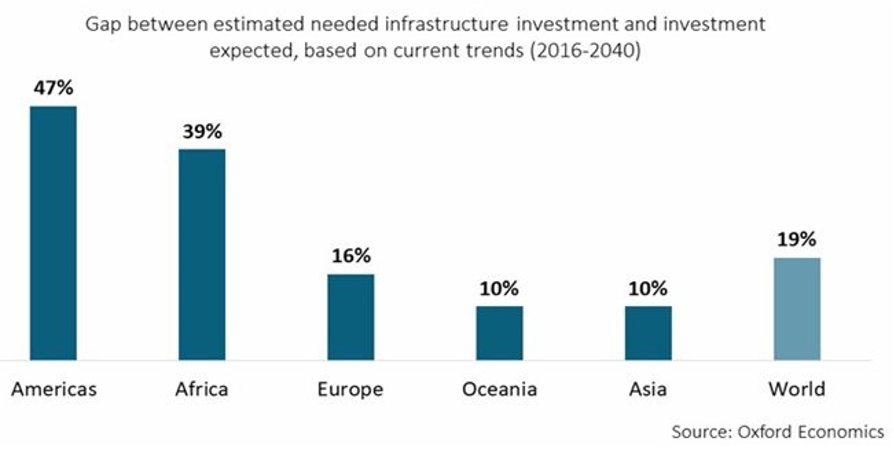Insights from New York on the Enabling Better Infrastructure guiding principles

|
| As part of the global launch of the Enabling Better Infrastructure Programme, a panel of infrastructure professionals in New York debated the principles and how they could apply to infrastructure delivery in the US. |
Contents |
[edit] The Guiding Principles
The Enabling Better Infrastructure Programme outlines 12 guiding principles to support decision makers around the world in delivering infrastructure investment plans to support their ambitions around sustainable development.
At the New York launch, hosted by Arup, infrastructure professionals, state officials and engineers from across the New York metropolitan area met to discuss the principles and hear from a panel how to apply the principles in the US.
Oxford Economics analysis shows that the infrastructure investment gap to 2040 in the Americas, is the highest for all regions at 47%. More specifically for the US, the gap is estimated to be an average of $494 billion per year – for roads alone, the estimated need is double the current forecasted spend.

|
| The Enabling Better Infrastructure Programme outlines 12 guiding principles to support decision makers around the world. |
This was the context behind the discussion. How do we deliver infrastructure investment to achieve more sustainable metro-areas, given that federal, state and city structures hinder strategic infrastructure planning?
[edit] The need to understand need
This hindrance from tiered governing structures for metro-areas was reflected in the panel discussion, which comprised Brian Fritsch from the Regional Plan Association, Dana Hecht from Port Authority of New York and New Jersey and Dana Omran from the Global Resilient Cities Network.
The Regional Plan Association, which fills the gap where pan-metro governance on infrastructure should be, produces detailed plans to inform infrastructure decision making based on need. But this arm’s length approach has its limits, with limited action being taken on some of its recommendations such as funding for the Gateway Tunnel program.
It was suggested state-wide plans for infrastructure do exist, but on paper rather than in practice. Many in attendance reflected on the need for leadership, which was a key theme to come from the Hong Kong preview of the Enabling Better Infrastructure programme.
[edit] Collaboration
In the absence of leadership, state officials have been seeking to collaborate to unlock funding. The 47% gap was recognised as a driving force, as this gap will keep growing unless we use infrastructure itself to drive up productivity and take advantage of the returns.
In the area of transport, city officials have been bringing together different projects focusing on standardisation in delivery to try to reduce costs which can then be used to fund future projects. Collaboration is also taking place on pooling resources and technical capability to deliver economies of scale to support ongoing investment.
[edit] Engagement
The discussion also focused on Principle 11 of the Enabling Better Infrastructure report. Many in the room felt there was a need for improvements in how city officials engage with communities. Within that, lessons from Hurricane Sandy have been learned: going to those affected to get their perspective is important.
Carrying this engagement through, as part of enacting Principle 7, was important to ensure projects were designed with co-benefits, resilience and multi-purpose use in mind. Using community engagement, to join up programme delivery, was seen as a bottom-up way of stimulating more strategic planning between agencies.
Despite the positive steps being taken, it was recognised that a greater understanding of best practice in strategic infrastructure planning for metro-areas that cut across state boundaries, within a federal system, would be helpful.
This article was originally published on the ICE Infrastructure Blog on 24 February 2020. It was written by Chris Richards, Head of Policy & Public Affairs.
--The Institution of Civil Engineers
[edit] Related articles on Designing Buildings Wiki
Featured articles and news
RTPI leader to become new CIOB Chief Executive Officer
Dr Victoria Hills MRTPI, FICE to take over after Caroline Gumble’s departure.
Social and affordable housing, a long term plan for delivery
The “Delivering a Decade of Renewal for Social and Affordable Housing” strategy sets out future path.
A change to adoptive architecture
Effects of global weather warming on architectural detailing, material choice and human interaction.
The proposed publicly owned and backed subsidiary of Homes England, to facilitate new homes.
How big is the problem and what can we do to mitigate the effects?
Overheating guidance and tools for building designers
A number of cool guides to help with the heat.
The UK's Modern Industrial Strategy: A 10 year plan
Previous consultation criticism, current key elements and general support with some persisting reservations.
Building Safety Regulator reforms
New roles, new staff and a new fast track service pave the way for a single construction regulator.
Architectural Technologist CPDs and Communications
CIAT CPD… and how you can do it!
Cooling centres and cool spaces
Managing extreme heat in cities by directing the public to places for heat stress relief and water sources.
Winter gardens: A brief history and warm variations
Extending the season with glass in different forms and terms.
Restoring Great Yarmouth's Winter Gardens
Transforming one of the least sustainable constructions imaginable.
Construction Skills Mission Board launch sector drive
Newly formed government and industry collaboration set strategy for recruiting an additional 100,000 construction workers a year.
New Architects Code comes into effect in September 2025
ARB Architects Code of Conduct and Practice available with ongoing consultation regarding guidance.
Welsh Skills Body (Medr) launches ambitious plan
The new skills body brings together funding and regulation of tertiary education and research for the devolved nation.
Paul Gandy FCIOB announced as next CIOB President
Former Tilbury Douglas CEO takes helm.
UK Infrastructure: A 10 Year Strategy. In brief with reactions
With the National Infrastructure and Service Transformation Authority (NISTA).























